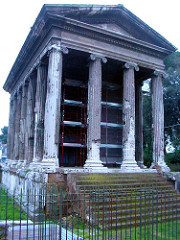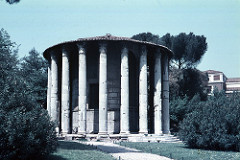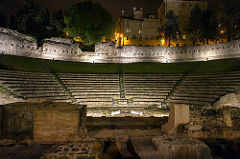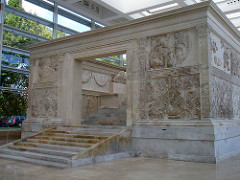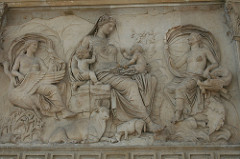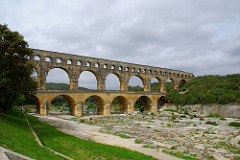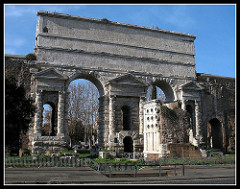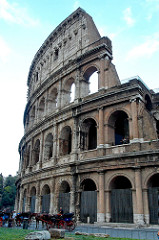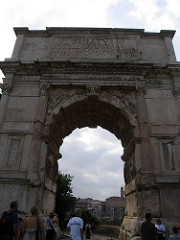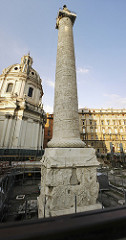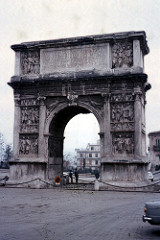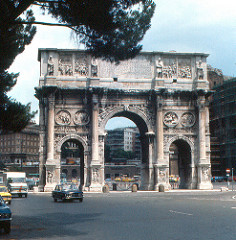Temple of Fortuna Virilis (Temple of Portunas)
75 BCE. Volcanic ash used in concrete. Roman, Greek, and Etruscan elements. 1 Cella with engaged columns - Ionic Order - Facade orientation, you are suppose to look at it from the front.
Temple of Vesta
Italy - Early First Century BCE, Frieze around the top, on entrace, and a round cella.
Amphitheater - "Double Theater"
Pompeii, Italy. 70 BCE. Outer wall is 2/3 stories tall. Cavea = Seating Area. Sits 20,000.
Atrium of the House of Vetti
Pompeii (standard floorplan). - Second century BCE, rebuilt in 62 - 79 BCE - Square at the bottom catches water. Axeal Symmetry,
Ara Pacis Augustae (Altar of Augustae Peace)
Rome. 13 - 9 BCE. Marble with no ceiling. Actual altar inside honoring Augustae as military leader. Shallow relief - decorative/historical.
Female Personification - Frieze from Ara Pacis
Frieze from east facade, depicts mother earth. Same date. Marble. 5'3'' high.
Marion Carree
1-10 CE. Used as outpost in Nines, France. Originally painted bright.
Pont du Gard
16 BCE - Foot Bridge on lower level, Aquaduct above. Part of a 30 mile Aquaduct. Asoanmasonry - Stone cute structure without mortar.
Porta Maggiore
Rome. 50 CE - Built by Claudius. Entrance +
"attic" two different aquaducts going in different directions. Rustication - "Rough" image to the stone, "dressed" is smooth.
Flavian Amiptheater AKA Colosseum
Begun in 70CE, completed by Titus (Ves's son) in 80CE. 160ft tall, 617ft wide and holds aprox 50,000. 80 columns all three orders. Named by Vespasian, who's family name was Flavian. Built over a lake, built as a political statement to reject Nero. Made out of concrete and faced with other stone. 2nd fliir has groin vaults and barrel vaults. - Possible Essay Question
Arch of Titus
81CE, built after military campaign through Jerusalem. Depicts the spoils of the Jews on Frieze. Built by Dumision (other son of Vesp) to honor Titus.
Forum of Trajan
Architect: Apollodorus of Damascus - Dedicated in 112CE. Part of the Quirinal Hill was removed, was a massive building for government.
Column of Trajan
Dedicated in 112CE. Located within the forum of Trajan. 128ft high, same height the hill used to be they had to cut out. Trajan and his wife are buried there. 625ft of Frieze showing the prolonged campaign and defeat of the Deaians. NOTE: Trajan extended the Roman empire to it's farthest boundary.
Arch of Trajan
114-118CE. Spandral.
Pantheon
Hadrian commissioned it. 142ft high, thickness of the base is 25ft. White and colored marble, different mixtures of concrete used. Dome was the largest in the oldest for 1,000 yrs. ITS THE ONE WITH THE GIANT WHOLE IN THE CEILING and no other windows. - Possible Essay Question
Arch of Constantine
312-315CE. 69ft high and 85ft wide. Marble. Built by Constantine himself. It's a triumphal arch/three portals. Took other pieces of other monuments and put it on. The famous symbol - Kairoto.
Aula Palatine
Trier, Germany. Early 4th Century Church. Wooden Ceiling. 220ft long - 106ft high. Apse: Circle/rounded ending.
First Style
Late 2nd Century BCE. Looks like marble/such, used to imitate. Geometric in design. Looks like colored stone, very rich.
Second Style
Bright, illustration landscape - depicts broken pediment.
Late Second Style
30-20 BCE/ 6'7'' high. Very realistic (birds and such). First of atmospheric view.
Third Style
10 BCE / 7'8'' high. Linear and Delicate. Monochromatic flat space/black - most feminine style.
Fourth Style
64-68CE/ Cpmbonation of 2 and 3 style. (Illusions and delicate- Illogical stuff starts to appears, details.
Detail of Fourth Style
62-79 CE. Aprox 1'2'' X 1' 1 1/2''. One of the first appearances of still life.
